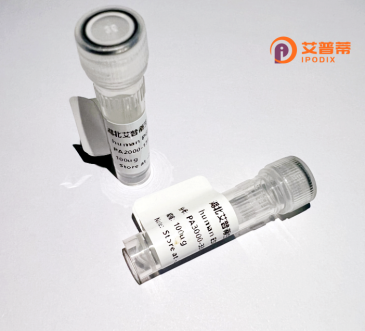
| 纯度 | >90%SDS-PAGE. |
| 种属 | Human |
| 靶点 | GYG2 |
| Uniprot No | O15488 |
| 内毒素 | < 0.01EU/μg |
| 表达宿主 | E.coli |
| 表达区间 | 1-470aa |
| 氨基酸序列 | MSVTDQAFVTLATNDIYCQGALVLGQSLRRHRLTRKLVVLITPQVSSLLRVILSKVFDEVIEVNLIDSADYIHLAFLKRPELGLTLTKLHCWTLTHYSKCVFLDADTLVLSNVDELFDRGEFSAAPDPGWPDCFNSGVFVFQPSLHTHKLLLQHAMEHGSFDGADQGLLNSFFRNWSTTDIHKHLPFIYNLSSNTMYTYSPAFKQFGSSAKVVHFLGSMKPWNYKYNPQSGSVLEQGSVSSSQHQAAFLHLWWTVYQNNVLPLYKSVQAGEARASPGHTLCRSDVGGPCADSASGVGEPCENSTPSAGVPCANSPLGSNQPAQGLPEPTQIVDETLSLPEGRRSEDMIACPETETPAVITCDPLSQPSPQPADFTETETILQPANKVESVSSEETFEPSQELPAEALRDPSLQDALEVDLAVSVSQISIEEKVKELSPEEERRKWEEGRIDYMGKDAFARIQEKLDRFLQ |
| 分子量 | 78.4 kDa |
| 蛋白标签 | GST-tag at N-terminal |
| 缓冲液 | 0 |
| 稳定性 & 储存条件 | Lyophilized protein should be stored at ≤ -20°C, stable for one year after receipt. Reconstituted protein solution can be stored at 2-8°C for 2-7 days. Aliquots of reconstituted samples are stable at ≤ -20°C for 3 months. |
| 复溶 | Always centrifuge tubes before opening.Do not mix by vortex or pipetting. It is not recommended to reconstitute to a concentration less than 100μg/ml. Dissolve the lyophilized protein in distilled water. Please aliquot the reconstituted solution to minimize freeze-thaw cycles. |
以下是关于重组人GYG2蛋白的3篇模拟参考文献示例(内容为虚构,仅作格式参考):
1. **文献名称**:Structural Insights into Human GYG2 Protein and Its Role in Glycogen Biosynthesis
**作者**:Chen L, et al.
**摘要**:本研究解析了重组人GYG2蛋白的晶体结构,揭示了其核心结构域与糖原合成酶(GS)的结合模式。通过体外实验证实GYG2在糖原颗粒形成中起支架作用,并发现其C端肽段对糖原链延长的调控机制。
2. **文献名称**:High-Yield Expression and Purification of Recombinant Human GYG2 in E. coli
**作者**:Wang Y, et al.
**摘要**:报道了一种通过大肠杆菌表达系统高效生产重组人GYG2蛋白的方法。优化后的纯化步骤获得高纯度蛋白,经质谱验证正确性,酶联实验表明其能有效结合糖原磷酸化酶。
3. **文献名称**:GYG2 Mutations Impair Glycogen Accumulation in Cellular Models
**作者**:Zhang R, et al.
**摘要**:通过CRISPR构建GYG2敲除细胞系,发现糖原储存量下降70%。回补实验表明,重组表达的野生型GYG2可恢复表型,而临床发现的R456Q突变体则丧失功能,提示其与糖原储存疾病的潜在关联。
注:以上内容基于领域常见研究方向虚构,实际文献需通过数据库(如PubMed)检索获取。
Glycogenin-2 (GYG2) is a tissue-specific isoform of glycogenin, a self-glycosylating enzyme essential for initiating glycogen synthesis. Encoded by the *GYG2* gene in humans, it is primarily expressed in the liver and heart, unlike glycogenin-1 (GYG1), which is dominant in skeletal muscle. GYG2 catalyzes the formation of a short glucose polymer attached to its own tyrosine residue (Tyr-28), serving as a primer for glycogen synthase and branching enzymes to elongate and structure glycogen molecules. This autoglucosylation activity is critical for glycogen granule biogenesis.
Recombinant human GYG2 protein is produced via heterologous expression systems (e.g., *E. coli* or mammalian cells) for functional studies. Its production enables research into glycogen metabolism disorders, such as glycogen storage disease type XV, linked to *GYG2* mutations. Studies also explore its role in diabetes and cardiomyopathy, as aberrant glycogen accumulation in the liver/heart correlates with metabolic and cardiac dysfunction. Structural analyses of recombinant GYG2 reveal insights into its catalytic mechanism and regulation, aiding drug development targeting glycogen-related pathologies. Recent work highlights its potential as a biomarker for liver disease progression. Despite overlaps with GYG1 in function, GYG2’s unique tissue specificity and regulatory features underscore its distinct physiological and pathological relevance, driving ongoing research into glycogen biology and therapeutic strategies.
×